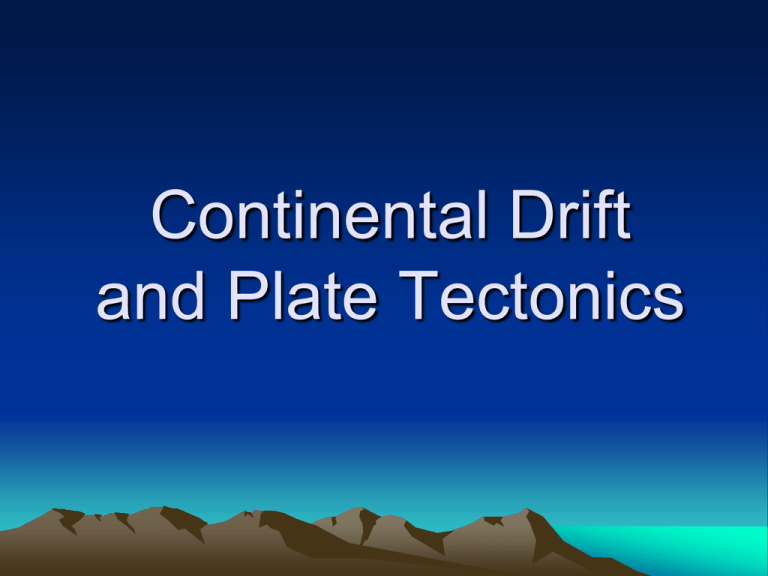Continental Drift and Plate Tectonics
advertisement

Continental Drift and Plate Tectonics Alfred Wegener 1880-1930 ● German scientist ● Introduced the Theory of Continental Drift in his book The Origin of the Continents and Oceans (1915) ● Many scientists had noticed the remarkable fit of the coastlines of South America & Africa ● First to use geological and paleontological evidence to show these continents were once joined Evidence of Pangaea Theory of Continental Drift • Proposed by Wegener in 1915 • Used evidence from climate, fossils and landforms to match up the continents • All of the continents were once joined in one large supercontinent called Pangaea and have since drifted apart • Wegener did not have a force to provide the movement so it was not accepted until the 1950’s ● Wegener spent much of his life defending his theory Wegener’s Continental Drift http://www.ucmp.berkeley.edu/geology/anim1.html 225 million years ago all continents connected in one land mass called Pangaea 180-200 million years ago Pangaea separated into Laurasia and Gondwanaland 135 million years ago Laurasia and Gondwanaland began to separate into continents 65 million years ago the continents move even further apart The position of the continents on Earth today Untold Tragedies of Continental Drift The Crust • This is where we live! • The Earth’s crust is made of: Continental Crust Oceanic Crust - thick (10-70km) - buoyant (less dense than oceanic crust) - mostly old - granite - thin (~7 km) - dense (sinks under continental crust) - Young - basalt Earth’s Interior • Lithosphere: Area of the crust and the upper mantle. – Crust: • Outer most layer • Continental crust (less dense granitic) • Oceanic crust (more dense basaltic) • Asthenosphere: – Rocks are at or near melting point – Exhibits plasticity – a solid that flows like a liquid Assignment In your spiral – draw and color a picture of the Earth’s interior, labeling the following: Wegener’s Puzzling Evidence 1. Label the land masses on each sheet. Color the fossil areas to match the legend below. 2. Cut out each of the continents along the edge of the continental shelf (the outermost dark line). Alfred Wegener's evidence for continental drift is shown on the cut-outs. Wegener used this evidence to reconstruct the positions of the continents relative to each other in the distant past. 3. Try to logically piece the continents together so that they form a giant supercontinent. India Antarctica S. America Africa Australia Plate Tectonics • Proposed in 1960’s by a variety of scientists including Hess, Dietz and Vine • Suggests that the lithosphere is broken up into many plates which are moving around the earth in different directions • All of the continents were once together in one supercontinent – Pangaea • Movement is caused by convection currents in the mantle of the Earth • Explained the cause of earthquakes, volcanoes, mountain building Plate Tectonics • Plate Tectonics: Theory that the Earth’s lithosphere is broken into plates and float on the asthenosphere • Convection Currents: Drives plate motion – hot magma rises from core, cools and sinks back to core – cycle starts over (think of a lava lamp) Double Bubble • Make a double bubble map of Continental Drift and Plate Tectonics CONCLUSION • Imagine you are Alfred Wegener in 1915. Write a Claim – Evidence – Reasoning about your theory of Continental Drift. • Use the evidence from the lab we just completed. Your reasoning you can come up with on your own (Remember it is 1915 and you are Wegener) CER Peer Editing • Claim – All continents were once joined together and have since drifted apart = 20pts Is it a complete logical sentence = 10pts • Evidence – Must mention at least 2 of the following: Dinosaur Fossils, Plant Fossils, Landforms (the way they fit together) = 30 pts Is it a complete sentence? = 10pts • Reasoning – Does it make sense? = 20 pts Is it a complete sentence? = 10pts Write the totals in the box at the bottom of the page







